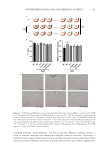186 JOURNAL OF COSMETIC SCIENCE (47) S. Nutten, Atopic dermatitis: global epidemiology and risk factors, Ann. Nutr. Metab., 66, s8–s16 (2015). (48) E.L. Simpson, T.M. Berry, P.A. Brown, and J.M. Hanifin, A pilot study of emollient therapy for the primary prevention of atopic dermatitis, J. Am. Acad. Dermatol., 63, 587–593 (2010). (49) E.L. Simpson, J.R. Chalmers, J.M. Hanifin, K.S. Thomas, M.J. Cork, W.H.I. McLean, S.J. Brown, Z. Chen, Y. Chen, and H.C. Williams, Emollient enhancement of the skin barrier from birth offers effective atopic dermatitis prevention, J. Allergy Clin. Immunol., 134, 818–823 (2014). (50) K. Horimukai, K. Morita, M. Narita, M. Kondo, H. Kitazawa, M. Nozaki, Y. Shigematsu, K. Yoshida, H. Niizeki, K-I Motomura, H. Sago, T. Takimoto, E. Inoue, N. Kamemura, H. Kido, J. Hisatsune, M. Sugai, H. Murota, I. Katayama, T. Sasaki, M. Amagai, H. Morita, A. Matsuda, K. Matsumoto, H. Saito, and Y. Ohya, Application of moisturizer to neonates prevents development of atopic dermatitis, J. Allergy Clin. Immunol., 134, 824–830 (2014). (51) F. Boralevi, M. Saint Aroman, A. Delarue, H. Raudsepp, A. Kaszuba, M. Bylaite, and G.S. Tiplica, Long-term emollient therapy improves xerosis in children with atopic dermatitis, J. Eur. Acad. Dermatol. Venereol., 28, 1456–1462 (2014). (52) G.S. Tiplica, F. Boralevi, P. Kommo, L. Malinauskiene, A. Kaszuba, C. Laurens, M. Saint-Aroman, and A. Delarue, The regular use of an emollient improves symptoms of atopic dermatitis in children: a randomized controlled study, J. Eur. Acad. Dermatol. Venereol., 32, 1180–1187 (2018). (53) A.J. Nopper, K.A. Horii, S. Sookdeo-Drost, T.H. Wang, A.J. Mancini, and A.T. Lane, Topical ointment therapy benefits premature infants, J. Pediatr., 128, 660–669 (1996). (54) M. Glatz, J-H Jo, E.A. Kennedy, E.C. Polley, J.A. Segre, E.L. Simpson, and H.H. Kong, Emollient use alters skin barrier and microbes in infants at risk for developing atopic dermatitis, PLOS One, 13, e0192443 (2018). (55) S. Seite, G.E. Flores, J.B. Henley, R. Martin, H. Zelenkova, L. Aguilar, and N. Fierer, Microbiome of affected and unaffected skin of patients with atopic dermatitis before and after emollient treatment, J. Drugs Dermatol., 13, 1365–1372. (2014). (56) D.P. Smack, A.C. Harrington, C. Dunn, R.S. Howard, A.J. Szkutnik, S.J. Krivda, J.B. Caldwell, and W.D. James, Infection and allergy incidence in ambulatory surgery patients using white petrolatum vs bacitracin ointment. A randomized controlled trial, JAMA, 276, 972–977 (1996). (57) S.E. Jacob and W.D. James, Bacitracin after clean surgical procedures may be risky, J. Am. Acad. Dermatol., 51, 1036 (2004). (58) R.M. Campbell, C.S. Perlis, E. Fisher, and H.M. Gloster Jr., Gentamicin ointment versus petrolatum for management of auricular wounds, Dermatol. Surg., 31, 664–669 (2005). (59) K.A. Gehrig and E.M. Warshaw, Allergic contact dermatitis to topical antibiotics: epidemiology, responsible allergens, and management, J. Am. Acad. Dermatol., 58, 1–21 (2008). (60) W.D. James, Use of antibiotic-containing ointment versus plain petrolatum during and after clean cutaneous surgery, J. Am. Acad. Dermatol., 55, 915–916 (2006). (61) J.F. Schechter, R.D. Wilkinson, and J. Del Carpio, Anaphylaxis following the use of bacitracin ointment. Report of a case and review of the literature, Arch. Dermatol., 120, 909–911 (1984). (62) M.A. Vale, A. Connolly, A.M. Epstein, and M.R. Vale, Bacitracin-induced anaphylaxis, Arch. Dermatol., 114, 800 (1978). (63) K. Greenberg, J. Espinosa, and V. Scali, Anaphylaxis to topical bacitracin ointment, Am. J. Emerg. Med., 25, 95–96 (2007). (64) R.I. Nijhawan, L.A. Smith, and K. Mariwalla, Mohs surgeons’ use of topical emollients in postoperative wound care, Dermatol. Surg., 39, 1260–1263 (2013). (65) A. Morales-Burgos, M. Loosemore, and L. Goldberg, Postoperative wound care after dermatologic procedures: a comparison of 2 commonly used petrolatum-based ointments, J. Drugs Dermatol., 12, 163–164 (2013). (66) M. Saco, N. Howe, R. Nathoo, and B. Cherpelis, Topical antibiotic prophylaxis for prevention of surgical wound infections from dermatologic procedures: a systematic review and meta-analysis, J. Dermatol. Treat., 26, 151–158 (2015).
187 Efficacy of Petrolatum (67) G.A. Genuino, K.V. Baluyut-Angeles, A.P. Espiritu, M.C. Lapitan, and B.S. Buckley, Topical petrolatum gel alone versus topical silver sulfadiazine with standard gauze dressings for the treatment of superficial partial thickness burns in adults: a randomized controlled trial, Burns, 40, 1267–1273 (2014). (68) H. Xiao, C. Li, X. Zhou, X. Wang, Z. Wu, L. Zhang, C. Liu, Z. Wang, H. An, Y. Wang, and S. Gao, A new method of microskin autografting with a Vaseline-based moisture dressing on granulation tissue, Burns, 40, 337–346 (2014). (69) S.H. Huang, C.H. Lin, K.P. Chang, S.H. Wu, S.D. Lin, C.S. Lai, S.F. Ou, and S.S. Lee, Clinical evaluation comparing the efficacy of Aquacel Ag with Vaseline gauze versus 1% silver sulfadiazine cream in toxic epidermal necrolysis, Adv. Skin Wound Care., 27, 210–215 (2014). (70) Z.D. Draelos, K. Ertel, P. Hartwig, and G. Rains, The effect of two skin cleansing systems on moderate xerotic eczema, J. Am. Acad. Dermatol., 50, 883–888 (2004). (71) K. Wei, C. Stella, K. Wehmeyer, J. Christman, A. Altemeier, R. Spruell, R. Wimalasena, G. Fadayel, and R.R. Wickett, Effects of petrolatum, a petroleum depositing body wash and a regular body wash on biomarkers and biophysical properties of the stratum corneum, Int. J. Cosmet. Sci., 43, 218–224 (2021). (72) I.E. Roseborough and A.J. McMichael, Hair care practices in African-American patients, Semin. Cutan. Med. Surg., 28, 103–108 (2009). (73) 21C.F.R. § 172.880 (1984).
Purchased for the exclusive use of nofirst nolast (unknown) From: SCC Media Library & Resource Center (library.scconline.org)
























































































